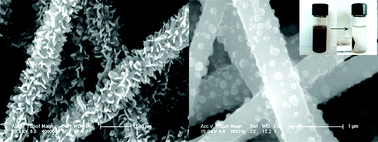Magnetically separable iron oxide nanostructures-TiO2 nanofibers hierarchical heterostructures: controlled fabrication and photocatalytic activity†
Abstract
Novel hierarchical heterostructures of TiO2 nanofibers separately decorated with

* Corresponding authors
a
Department of Chemistry, Jilin University, Changchun, P. R. China
E-mail:
yangqb@jlu.edu.cn
Fax: +86-431-88499576
Tel: +86-431-88499576
b State Key Laboratory of Supramolecular Structure and Materials, Jilin University, Changchun 130012, P. R. China
c Department of Chemistry, Drexel University, Philadelphia, USA
Novel hierarchical heterostructures of TiO2 nanofibers separately decorated with

 Please wait while we load your content...
Something went wrong. Try again?
Please wait while we load your content...
Something went wrong. Try again?
H. Wang, X. Fei, L. Wang, Y. Li, S. Xu, M. Sun, L. Sun, C. Zhang, Y. Li, Q. Yang and Y. Wei, New J. Chem., 2011, 35, 1795 DOI: 10.1039/C1NJ20051H
To request permission to reproduce material from this article, please go to the Copyright Clearance Center request page.
If you are an author contributing to an RSC publication, you do not need to request permission provided correct acknowledgement is given.
If you are the author of this article, you do not need to request permission to reproduce figures and diagrams provided correct acknowledgement is given. If you want to reproduce the whole article in a third-party publication (excluding your thesis/dissertation for which permission is not required) please go to the Copyright Clearance Center request page.
Read more about how to correctly acknowledge RSC content.
 Fetching data from CrossRef.
Fetching data from CrossRef.
This may take some time to load.
Loading related content
